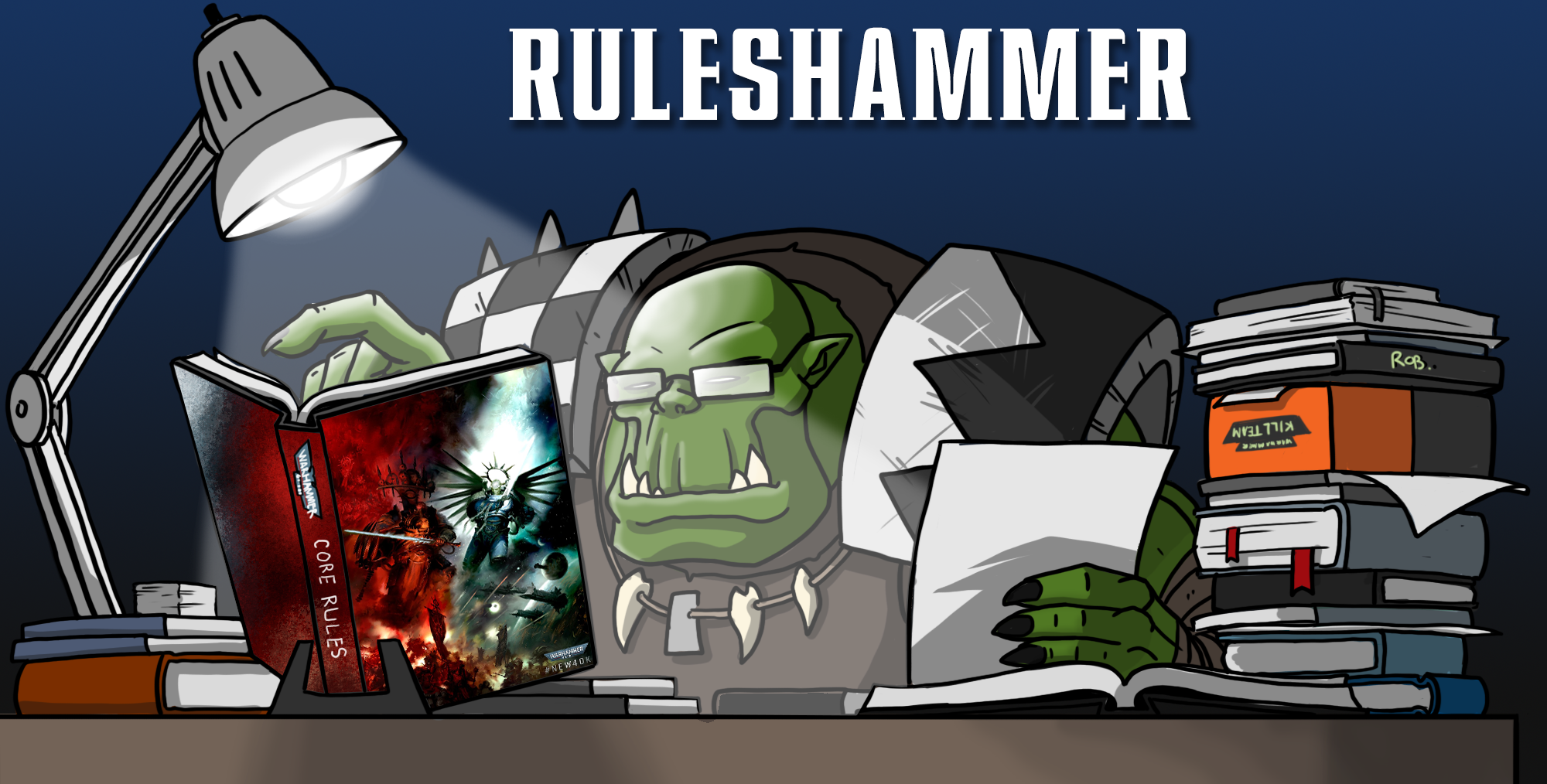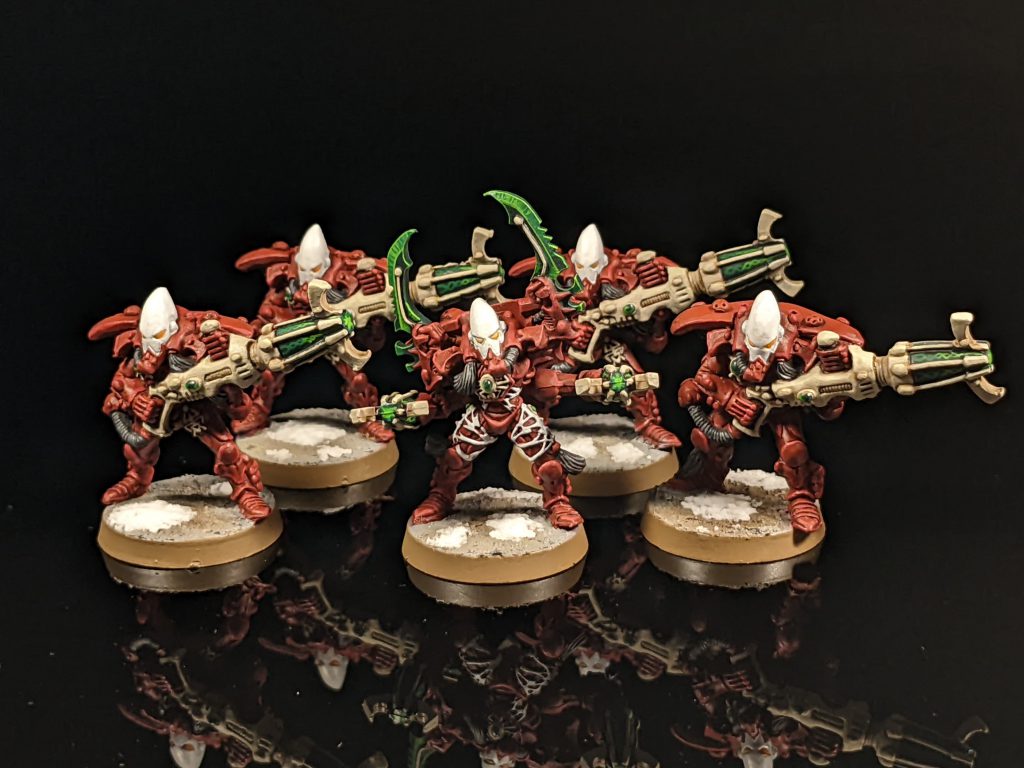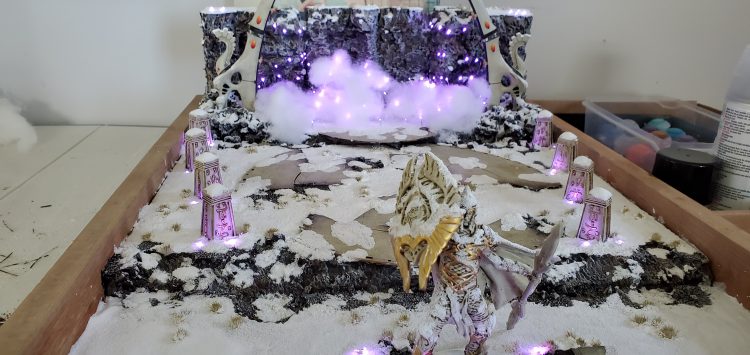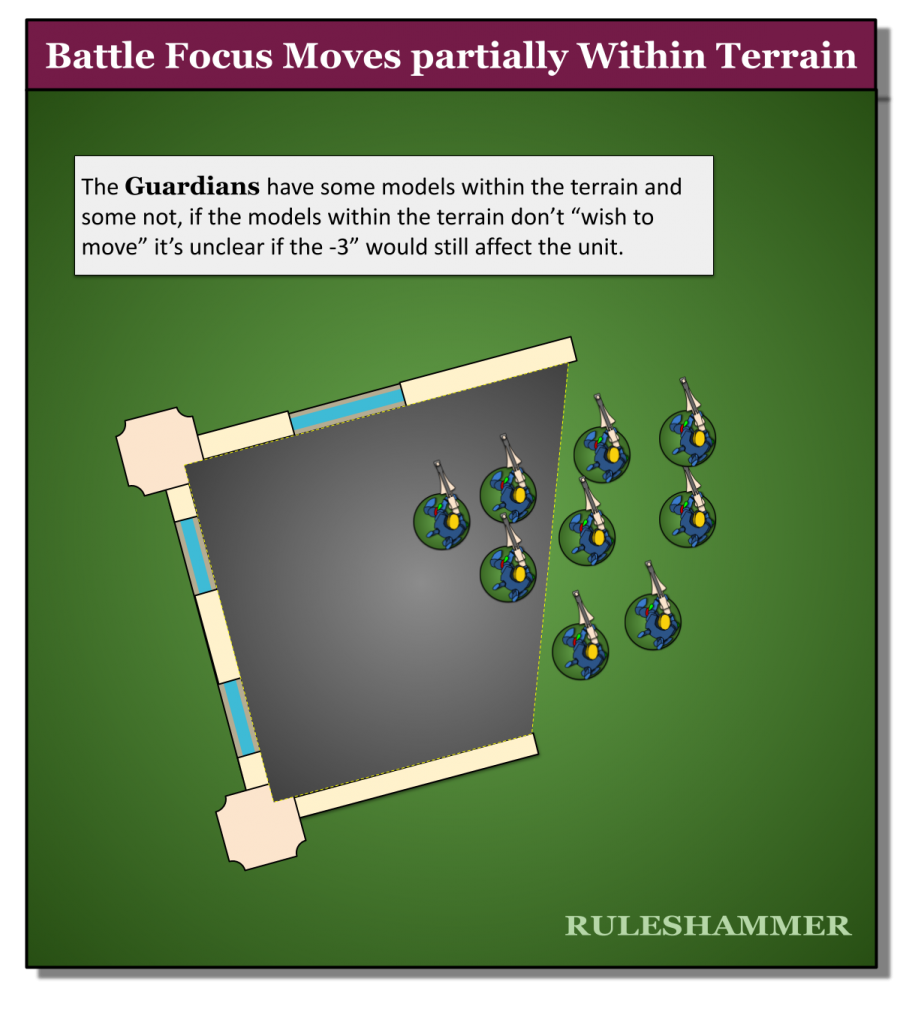Welcome to Ruleshammer Aeldari – the one place to look for Ruleshammer Q&A on Aeldari issues! You can also find answers to many more questions in the Ruleshammer Compendium! Last Updated: 2022-03-10
 Aeldari are a complex faction with a lot of interplay between this book and Codex Drukhari. Expect list building to have more questions here than other books!
Aeldari are a complex faction with a lot of interplay between this book and Codex Drukhari. Expect list building to have more questions here than other books!
Current Q&A
Table of Contents
Ynnari Detachments with non-Asuryani and Strands Of Fate
Q. If an Ynnari Detachment includes Harlequin or Drukhari units (p.92), does the army lose access to Strands of Fate?
Rules as written, the current answer to this is Yes – they do lose Strands of Fate.
If every unit from your army has the Asuryani keyword and is drawn from the same craftworld (excluding models with the ANHRATHE or UNALIGNED keywords), then at the start of each battle round, you can make a Strands of Fate Roll.
What is slightly odd about this however is that the Ynnari Detachement still counts as an Asuryani detachment even with Drukhari or Harlequin models in it. Strands of Fate just doesn’t seem to care.
A Craftworld detachment that is from the Ynnari can also include HARLEQUINS units, <KABAL> DRUKHARI units, <WYCH CULT> DRUHKARI units, INCUBI units, and SCOURGES units (see Codex: Drukhari), but for each of these units it includes it must also include on ASURYANI unit with the same battlefield Role. A YNNARI Detachment that includes any of these units in this way is still considered to be an ASURYANI Detachment, but the following additional rules apply:
So does that indicate intent that Strands of Fate and Ynnari with some Drukhari support should work? Potentially. Drukhari units in these detachments will lose access to Power From Pain so it’s not like taking them doesn’t already have an ability deficit.
Pre-FAQ Suggestion: As Ynnari detachments are meant to count as Asuryani Detachments and force the inclusion of Asuryani units per none Asuryani unit. As such I think Strands of Fate is intended to work assuming the entire army is Ynnari (for the same Craftworld resitriction).
Ranger Cloaks and benefits of Cover
Q. Rangers (p.154). If a unit of Rangers is receiving the benefit of Dense Cover, but not Light Cover, do they add +1 to their armour saves from their Ranger Cloaks?
Ranger Cloak: Each time a ranged attack is allocated to to a model in this unit while it is receiving the benefits of cover, add an additional 1 to any armour saving throw made against that attack.
So I think the answer to this is yes. Dense cover is a “benefit of cover” just one with slightly different criteria to the more typical Light and Heavy cover.
IGNORING THE BENEFITS OF COVER
…
If a rule says that the target ‘does not receive the benefits of cover that impose penalties on hit rolls’, then, when resolving an attack with that rule, models in the target unit ignore all benefits received from terrain traits that impose penalties on hit rolls (e.g. Dense Cover).
If a rule says that the target unit ‘does not receive the benefit of cover’, without specifying what benefits are ignored, then, when resolving an attack with that rule, models in the target unit ignore all benefits received from all terrain traits, including those that improve its saving throws, impose penalties on hit rolls and so on.
So if a Ranger is in position to have the benefit of Dense cover, then they will also gain +1 to their saves from their cloak.
Warp Spiders Exarch: Web Of Deceit after Coming in as Reinforcements
Q: Can Warp Spiders with a Web of Deceit Exarch use Web Of Deceit in the same turn as arriving from Reinforcements?
Pretty emphatic No on this. To use Web Of Deceit, a unit must be able to make a Battle Focus move.
Once per battle, if this unit contains Warp Spider Exarch model, instead of making a Battle Focus move (pg142), you can remove this unit from the battlefield and set it up up again anywhere on the battlefield that is more than 9″ away from any enemy models.
and units that arrive as Reinforcements cannot make Battle Focus moves.
BATTLE FOCUS
…
A unit that makes a Battle Focus move cannot Embark within a TRANSPORT model at the end of that move, and until the end of the turn, such a unit is not eligible to declare a charge. A unit cannot make Battle Focus move if it arrived as Reinforcements this turn, and a unit cannot make more than one Battle Focus move per turn.
seeing as the Web of Deceit ability is specifically instead of making a battle focus move, then a unit that can’t make such a move can’t do something else instead of not making it.

Wraith Guard – War Construct and D Scythes
There’s a few quirks of this rule, first lets look at the wording.
War Construct: Models in this unit can make attacks with ranged weapons even while their unit is unit is within Engagement Range of enemy units, but each model can only make attacks against enemy units that they are within Engagement Range of. In such circumstances, models in this unit can target enemy units even if other friendly units are within Engagement Range of the same enemy unit.
So this is pretty similar to both Big Guns Never Tire and the more recent rule for T’au Battlesuits. It doesn’t have the -1 for Heavy Weapons clause but Wraith Guard can’t carry such weapons anyways so that part doesn’t matter. And it’s also missing the section on being able to target outside of combat if the enemy models within Engagement range die, however that facet of both Big Guns Never Tire and the Battlesuit abilty are actually just reminder notes. I’ve covered before that you can do this with Pistols and you can do this with Wraith Guard despite it missing because of how Locked in Combat is worded.
LOCKED IN COMBAT
Models cannot make attacks with ranged weapons while their unit is within Engagement Range of any enemy models. Models also cannot target enemy units within Engagement Range of any other units from your army – the risk of hitting your own troops is too great.
Notice that it doesn’t say “can’t shoot” or “can’t target,” it says “cannot make attacks” which is a step after picking a unit to shoot and after targeting. So you can do both of this things, the model just can’t “make attacks” if when you get to those attacks there are still enemy models within Engagement range.
The other issue is D-Sycthes as weapons; they’re Blast, plus you can’t mix the weapons in the unit so if you swap to D-Sycthes this ability loses all functionality. I personally think that this is an oversight (see my Pre FAQ suggestion below), that it’s Blast’s rule that limits its use within Engagement Range rather than as a feature of Big Guns Never Tire was a point of discussion when Battlesuits was previewed.
Pre-FAQ Suggestion: This unit can have models target outside of Engagement Range in a way similar to Big Guns Never Tire as per the Locked In Combat wording.
If you’re really looking to use D Scythes while locked in combat, I might suggest that they can be used against enemy units within Engagement Range but do not benefit from the Blast Rule when doing so.
Webway Gates
Placement Rules
The current wording for Webway gates doesn’t actually limit them to setting in a configuration you’d recognize as a Webway “arch”. The two halves must be within 3″ of each other but the rules do not set a minimum distance on their separation, either. So under the rules as written they can be placed right next to one another. This vastly increases the “wholly within” 6″ area that models can come in from and decreases the size profile of the feature. I think for now events will likely go with these as written, so expect to see some very well tesselated Webway gates. It’s not immediately clear to me how best to write a rule that causes them to be set up as an arch. Nothing geometric and succinct comes to mind. The closest I’ve come to a working suggestion is below.
Pre-FAQ, SUPER “OUT THERE” SUGGESTION: For a model to be deployed via a Webway Gate a position must exist that the model can be placed where a straight line drawn between where one Wraithbone arch touches the battlefield crosses through the placed model and then reaches the other Wraithbone arch. Once established that this is possible the model can set up anywhere wholly within 6″ of both Arches.
Unit or Terrain Feature?
One other slight oddity of the webway gate is its unit status. Once deployed, the gate is to be treated as a Obstacle Terrain Feature. It does not have the BUILDING keyword, and it does not have a profile. Terrain Features can never be declared as a target of an attack, and fortification units can not control objectives, or be picked for To The Last (though at 90 points, well done if you manage to make this thing one of your top 3 expensive units). But is it still a unit? I don’t think it is once it’s deployed; I think it stops being one when you start treating it as an obstacle. However its ability does use the wording:
…friendly Webway Gate unit…
however I expect this is a mistake and it should instead say “friendly Webway Gate Terrain Feature” similar to the Sororitas Battle Sanctum. If it doesn’t stop being a unit then enemy models would not be able to move within 1″ of it, which doesn’t fit with how other Terrain Features work. Again the Battle Sanctum becomes an Area Terrain Feature, if it was still a unit than no models would be able to benefit from it’s traits as you can’t put units on top of other units.
Pre-FAQ Suggestion: Treat Webway Gates as a Terrain Feature and not as a unit once deployed. This means the enemy can move within 1″ of them.
Update! A few readers have helped me out with few different ways that treating the Gate as a unit causes significant issues; here’s a few of them.
- You could charge the Webway gate but not fight it because it’s an Obstacle Terrain Feature that you can’t target with attacks, you could do this so that your unit was controlling a nearby objective and you’d have a unit that can’t be shot at next turn because the gate can’t move to fall back.
- If it’s a unit then it could be consider the “nearest visible enemy unit” for Smite which is not an attack so would bypass the obstacle rule’s ban on targeting.
Strands of Fate And Re-rolls
Q: If I use Strand of Fates to treat one dice of a 2D6 check as an unmodified 6, and then re-roll that roll. Do I need to re-roll the Strand of Fate dice?
Had quite a lot of interest around this one and I didn’t want to cover it til I’d actually talked to Eldar players about it, there’s also a lot of comparisons to Miracle Dice happening that I’m not sure are helpful; something I’ll elaborate on. There’s a key difference to Miracle Dice and that is that they always count as unmodified 6s but the rolls you can use them on are what is randomly determined. My current answer on if you’d have to re-roll the Strand of Fate dice is no. I think there’s enough there to support this even though it’s not specifically mentioned like it is for Miracle Dice. Lets clear up why I think that’s a bit of a red herring first, Miracle Dice have a value determined by rolling them but Strand of Fate dice do not. If you roll a dice and treat is as an modified 6 it’s always an unmodified 6, if you roll a dice and it has a value it has that value. Miracle dice would be the latter without the “do no re-roll these dice rules. So what rules support not having to include them in the re-roll; firstly Strand of Fate itself.
If that type of roll involves more than one D6, treat on of those dice an unmodified roll of 6 (do not roll that dice), then roll any other dice and add up the results.
If you re-roll a roll, the old roll didn’t happen (except in as much as to prevent re-rolling again). For all other purposes this is the charge roll you are making still. This rule says when making this charge roll treat one of the dice as an unmodified 6 and do not roll it, I don’t think that ends mid roll. There’s also this section about unmodified rolls.
You can never re-roll a dice more than once, and re-rolls happen before modifiers (if any) are applied. Rules that refer to the value of an ‘unmodified’ dice roll are referring to the dice result after any re-rolls, but before any modifiers are applied.
Which admittedly is a little circumstantial as evidence goes but supports the idea that if you are treating a roll as unmodified an unmodified result is “after re-rolls”.
I still think this could be made clearer with an FAQ, and I could be completely wrong this is a real close one.
Pre-FAQ Suggestion: If you re-roll a roll of multiple dice and have used Strand of Fate to affect this roll, do not re-roll the Strand of Fate dice just re-roll the other dice.
Batle Focus Moves and Models within Area Terrain
The Battle Focus move has restrictions when models are moving over area terrain, but what if the models are already on the terrain and don’t “wish to move”? Let’s check the rule first.
Battle Focus Moves Through Area Terrain
If a unit make a Battle Focus move and any of it’s model wish to move over any part of an Area Terrain Feature, subtract 3″ from the distance models in that unit can move when making that Battle Focus move (to a minimum of 0). This penalty applies even if every part of that Area Terrain feature is 1″ or less in height, but is not cumulative with any other penalties that Area Terrain feature may impose (e.g. the difficult ground terrain trait).
So really what the heck does “wish to move” mean. Like if you’re using Battle Focus then don’t all the models wish they could move and some of them can’t because they’re on a terrain feature? I’m not being serious with that suggestion but it’s pretty odd phrasing. Especially as if any of them wish to move, the 3″ subtraction is for the every model in the unit. So what if you’re in the situation below?
I’m really not sure if the rule sufficiently covers this situation; if the units rolls a 3 for their Battle Focus move, can the unit move at all? Personally I lean to yes, if you don’t move any of the models already on the terrain but we really could use an FAQ to clear this up.
Pre-FAQ Suggestion: If some models in a unit are not within Area Terrain when using the Battle Focus move ability then you can move those models the full amount rolled so long as the models that are within the area terrain do not move.
Strands of Fate and The Selectable Keywords FAQ
I’ve had a few people asking me about this FAQ and if it interacts with Strands of Fate (SoF) or for that matter any other “all your army” abilities.
Q: Are named characters exempt from the rules that require every unit that has a selectable keyword to have the same selectable keyword?
A: Yes. Though named characters can have sub-faction keywords these are typically predetermined and not selected by the player (i.e. they are not typically presented within angular brackets).
The short answer is no. This FAQ is not about rules that give an army an ability for all sharing a keyword, it’s about rules that require an army all have the same selectable keyword.
Strands of Fate doesn’t require or enforce they all be the same, it rewards having the same <CRAFTWORLD>
If every unit from your army has the ASURYANI keyword and is drawn from the same CRAFTWORLD
like it’s a question not a imperative. Strands would need to be
All units with the Strands of Fate ability must be drawn from the same <CRAFTWORLD>
to say it “requires all selectable keywords be the same”, where as
All of the units in a player’s army that have selectable Faction keywords – that is Faction keywords presented in angular brackets that a player selects when they add those units to their army – must all have the same selectable keywords.
This rule from GT2022 Nachmund is requiring they all be the same, the keyword there being “must”. So this doesn’t allow an army to include The Yncarne to be in a different <CRAFTWORLD> army and keep Strands of Fate.
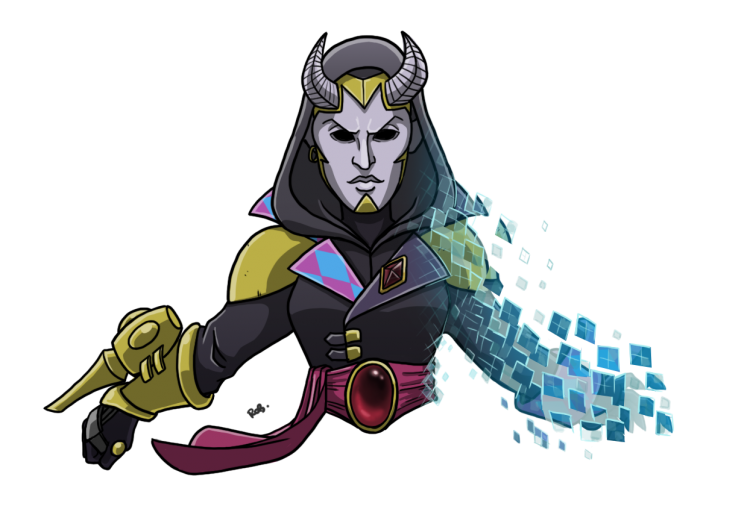
Mirror Architect and Solitaire
Q: If I have a Harlequin Troupe with a mirror architect Shadowseer and a Solitaire standing in the middle of them, can the troupe protect the solitaire with look out sir? Or does mirror architect mean he counts as the closest model, even though he isn’t actually the closest model?
I think as odd as this interaction is the current answer is yes, but lets look at why; what does Mirror Architect do is a good place to start.
Mirror Architect (AURA)
While a friendly <SAEDATH> unit is within 6″ of this model, each time an enemy units is selected to shoot, when measuring range to any model in that <SAEDATH> unit, that model in that <SAEDATH> unit is considered to be an additional 6″ away from the shooting model.
So in a normal Look Out, Sir scenario, a unit of Troupes would be able to protect a character. Like the Marines in this Diagram below are protecting a Librarian.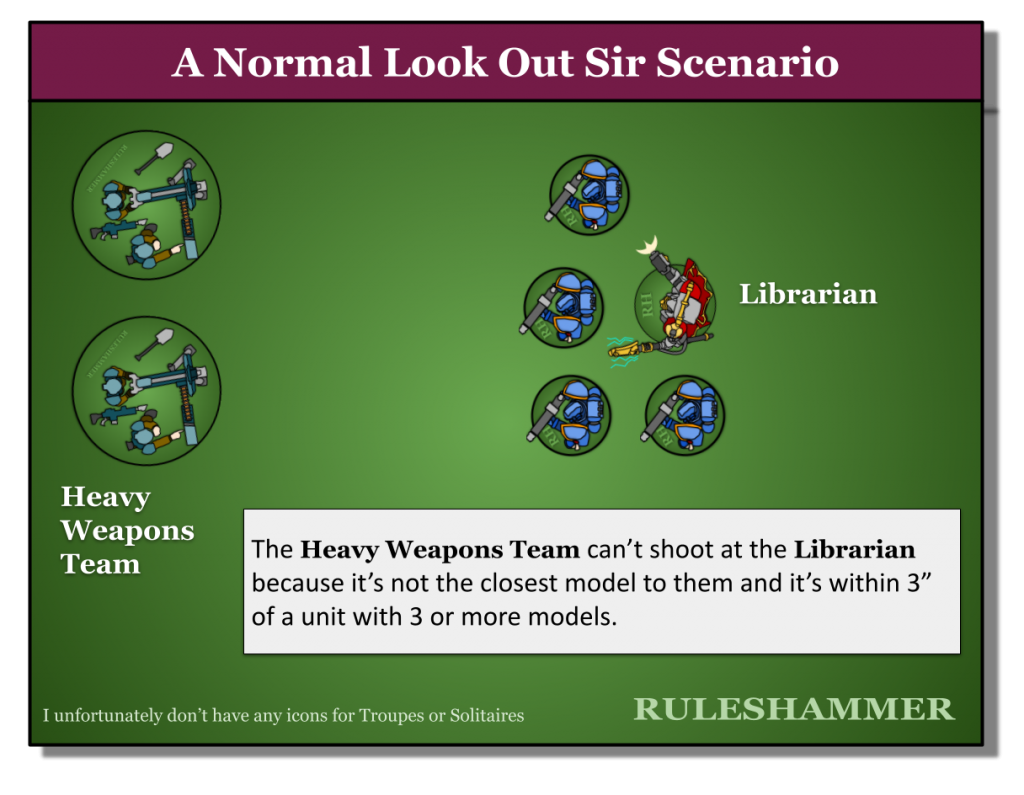
However if the Shadowseer gets within Range of that Troupe unit, then when measuring range to them for shooting your opponent will treat them as being 6″ further away. This would be fine if the Character they were protecting was also affected by the Aura, however Solitaires don’t have the <SAEDATH> keyword. So while the Troupe unit now counts as further away a Solitaire will not, potentially making it the closest enemy model and removing the protection of Look Out Sir.
Strands of Fate, Luck of the Laughing God, and missing exclusions
Both of these abilities have some pretty clear exclusions missing.
If every unit from your army has the Asuryani keyword and is drawn from the same craftworld (excluding models with the ANHRATHE or UNALIGNED keywords), then at the start of each battle round, you can make a Strands of Fate Roll.
Strands of Fate is missing an exclusion to let you ignore Pheonix Lord units for this check. I say it’s obvious that this is missing because Asurmen, Baharroth, Fuegan, Jain Zar, etc all have Strands of Fate as an ability on their Datasheets. If including them was intended to break Strands of Fate they wouldn’t have the ability.
Pre FAQ Suggestion: Play as if “Pheonix Lord” is included after ANHRATHE in the list of units to exclude from the “drawn from the same craftworld” check.
Similarly the same issue exists for Luck of the Laughing God and Solitaires.
If every unit from your army has the HARLEQUINS keyword and is performing the same SAEDATH (excluding units with the UNALIGNED keyword)…
it’s just Solitaires but like Pheonix Lords and SoF, they do have Luck of the Laughing God on their Datasheet.
Pre FAQ Suggestion: Play as if SOLITAIRE units are excluded from the “same SAEDATH” check for Luck of the Laughing God.
GW FAQed
Nothing Yet.
Have any questions or feedback? Got a rules question you want answered? Drop us a note in the comments below, ask a question in our Ruleshammer form, or head over to r/ruleshammer to discuss.
